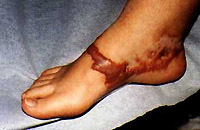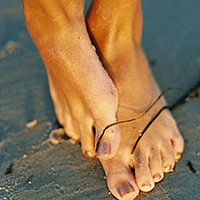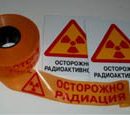In the treatment of different types of scars, combinations of several methods are used: for example, operations and laser grinding (or dermabrasion) after it.
Content
Scarring
In our, distant from perfection, the world there is hardly a person who does not have any scar on his body. Scars differ in color, size, relief and structure. However, there is something that unites them - they constantly resemble the transferred injury or inflammation.
 Depending on the appearance and its histological structure, the scars are divided into nylons (in the surrounding skin), atrophic (seal below the skin level), hypertrophic (towers above the skin) and keloids (significantly exceed the size of the primary injury).
Depending on the appearance and its histological structure, the scars are divided into nylons (in the surrounding skin), atrophic (seal below the skin level), hypertrophic (towers above the skin) and keloids (significantly exceed the size of the primary injury).
Nimmotrophic scars, the most «innocuous». They are formed due to the adequate response of the body to injury. After all time, they become thin, whitish color, do not cause physical inconvenience to the owner. These scars, as a rule, do not need correction. The exceptions are cases of aesthetic improvement of the appearance of the scar, smoothing its surface or accelerate the tempo of normalization of color.
Atrophic scars, often consequences of injury and acne. The leather over the rubber scar, has a transverse allocation (with linear scars), often such scars are deprived of pigment and therefore look white. The characteristic type of these scars is due to the defect of connective tissue under the scar, deficiency of collagen and elastin, the main proteins forming the skin frame.
Hypertrophic scars as well as keloids rise over the surrounding skin, but unlike the latter, remain within damage. They arise, as a rule, after operational interventions and injuries as a result of inadequate inflammation, the addition of secondary infection, a decrease in local immune reactions, endocrine dysfunctions, etc.
Celoids are formed on the place of burns, injuries, after inflammatory processes and operations. Celoids can be active (growing) and inactive (stable), regardless of the statute of scar. Most often, they are localized in the area of the Ear, Zone decollete and shoulders. The active scar is growing and causes pain, itching, the feeling of numbness, emotional disorders, has the kind of a tense red scar, often with a blue tint. Inactive keloid - does not grow, subjectively does not bother the patient, the color of the scar pink, or approaches the color of normal skin.
At the stage of formation of the scar, it is impossible to predict whether this scar is normal or hypertrophic, or will turn into a keloid. Therefore, all scars must be under the supervision and control of the specialist.
The earlier the patient appeals to the doctor, the more effective and faster it can be corrected.
In most cases, there is a need for a combination of two or more correction methods, they use them in stages, as the scar ripening. For example, using microdermabrasion or peeling remove the top layer of the skin in order to then applied to the scar of the substance and artificial coatings could have a deeper effect. Also apply creams and gels containing various active substances.
And if the scar does not heal
In the absence of qualified treatment or late its beginning, an uncontrolled growth of the scar can begin, or develop a connecting tissue defect. If the scar is located in the joint area, there may be a contracture with limiting the volume of movements.
Keloid scars after excision start growing even stronger.
Rubar correction
When it is better to start the scar correction?
Begin treatment and correction is better immediately after the injuries suffered, at the stage of formation of the scar. The earlier the treatment started, the less noticeable can be made a scar.
Method of treatment of scars
How to select a method of treatment?
The choice of the method depends on the phase of the development and localization of the scar, as well as the age of the patient, its sex and skin type. Given the individual features, the doctor selects the most effective method.
The difference in the treatment of the scar from correction
What is the difference between the treatment of the scar from correction?
At the stage of development of the scar, he is treated. This allows you to reduce swelling, normalize blood circulation and collagen synthesis, ensure the prevention of secondary infection. And if the scar has already formed - its correction is held. The doctor smoothes the scar in height, normalizes its color and skin texture.
Visit doctor
How often the patient should attend a doctor?
During the treatment of the scar 2-4 times a week, during its correction, once every 10-30 days.
How much time may occupy scar?
Than younger scar, the less time it may be necessary for his treatment. From the beginning of therapy until the final result is obtained, for example, in the treatment of a hypertrophic scar, it may be necessary from 2 to 12 months, and the restoration of the atrophic scar can be achieved and after one procedure.
Lightening scar
Is it possible to clarify the formed scar?
If the red scar is due to the presence of excess vessels in it of excessive vessels. In this case, it can be discouraged by treating the vascular laser. At the same time, the vessels are glued, and the scar is gradually pale. If the color change is due to pigmentation, then dermabrasion can be recommended, peelings, whitening creams.









